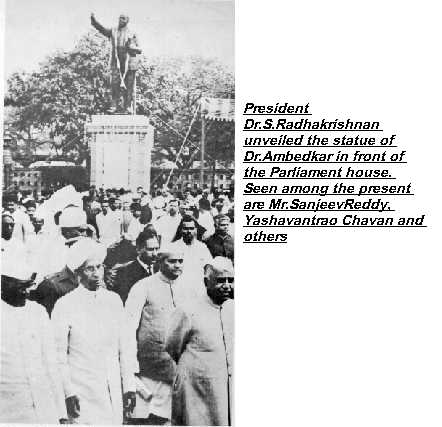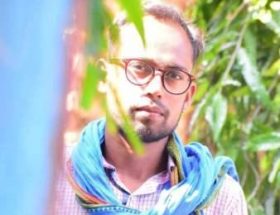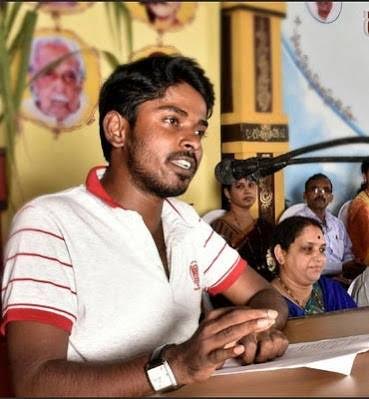A brief note on Dalit literary movements in Maharashtra
Daisy Katta
 Revolutions are stirred on paper and are born out of pens and inks. Revolutionary movement categorically uproots the very being of an accepted thought and tries to negate, challenge, eradicate social evils, thus creating an atmosphere of non-conformity. Literature is a vehicle for any revolution. Like Rousseau and Voltaire contributed immensely to the French Revolution, the Russian Revolution is indebted to the writings of Karl Marx, Lenin, Gorky, and Mayakovsky. But how did these revolutionary ideas become so widespread that not only did they become a social and political force but also a cultural force equally? They were united not only by ideological affinity but also by cultural purpose.
Revolutions are stirred on paper and are born out of pens and inks. Revolutionary movement categorically uproots the very being of an accepted thought and tries to negate, challenge, eradicate social evils, thus creating an atmosphere of non-conformity. Literature is a vehicle for any revolution. Like Rousseau and Voltaire contributed immensely to the French Revolution, the Russian Revolution is indebted to the writings of Karl Marx, Lenin, Gorky, and Mayakovsky. But how did these revolutionary ideas become so widespread that not only did they become a social and political force but also a cultural force equally? They were united not only by ideological affinity but also by cultural purpose.
There have been many revolutionaries who fought not with physical might but with the sheer brilliance of the mind. Within such social movements there were a few revolutionaries who turned to writing and writers who turned to revolution. There is a fancy term used in academia, “Subaltern Literature”, literature written by the marginalized, literature of that sections of society which is kept out of the “democratic space”, depriving them of any opportunities to create any kind of social, cultural or economic capital. Subaltern literature did not celebrate the “great men” of the country but sang the songs of those very labourers (so-called “subaltern masses”) on whose backs these “great men” stood.
Subaltern literature came into being to formulate a narrative of the struggles and injustice faced by the marginalized communities. Fighting for a cultural social space was needed also to expand the psychological space equally. Much has been spoken about post-colonial writing, especially India being a former colonized country. Nationalist writers in the 1950’s and 1960’s were male, middle-class and privileged and their chosen medium still remained the colonizers’ tongue. “Those who wrote to reclaim the territory still remained mere overseers, middleman, spokesperson for people yet alienated from them because of their privilege” (George, 1991).

Copies of ‘Golpitha’ being distributed during the funeral of the poet Namdeo Dhasal.
Post-colonial writers like V.S Naipaul, who depicted a triple colonial mentality since he was born in Trinidad, educated in England and then landing up in India and weaving the narrative of Indians on foreign shores, was applauded for his writing. But these narratives were not the real narratives of India. The post-colonial era was a period when the writers were free to express themselves in a new found psychological freedom, where their writings had an acceptability in the social sphere. But such sociological, cultural and psychological space was deprived to Dalits since the Savarna colonizers never left India even after the British left, hence a mental and physical colonization of the marginalized continued in India much after the independence. In this manner, the real post-colonial writing could only begin with the Dalit Literary Movement of the 1960’s.
Rebels of the Past
The beginnings of Dalit literary movement is generally traced back to the Bhakti Movement of the medieval century.The Bhakti saint-poets attacked the canonical Hindu practices, but Bhakti movement still remained within the realm of Hinduism and was not an immediate threat to the caste system and the hegemony of Savarmas, though it provided avenues to the likes of Chokhamela where they could vent their grievances. Chokhamela, a famous Mahar poet of the Bhakti movement and also the Varkari Movement in Maharashtra says in his poetry:
“If you had to give me this birth,
Why give me birth at all?
You cast me away to be born; you were cruel,
Where were you at the time of my birth?
Who did you help then?
Kabir also questioned the sense of purity he asked the twice born:
“Tell me, O pandit,
what place is pure
where I can sit
and eat my meal?”
Voices of Dissent in Maharashtra
After independence, though the marginalized were part of this newly formed “Indian Nation”, it was rather a symbolic formation than a natural entity. Since the essence of a nation does not lie in the boundaries within which the citizens live, but lies in the collective consciousness of belonging. Here even after 150 years of British rule the Savarna identity remained intact and was again growing claws. Ambedkar’s thought was the fountainhead of the emergence of Dalit Literature. Dr Babashaeb Ambedkar’s seminal text Annihilation of Caste become the moving spirit in asserting the identity for the marginalized. This literature also acted as a catalyst in the broad movement of resistance. In 1958, that the term “Dalit literature” was used for the first time, when the first conference of Maharashtra Dalit Sahitya Sangha (Maharashtra Dalit Literature Society) was held at Mumbai, a movement driven by thinkers like Jotiba Phule and Dr Babasaheb Ambedkar.
Poets and writers like Baburao Bagul, Anna Bhau Sathe, Shankarrao Kharat, Yashwant Manohar, Daya Pawar, JV Pawar, Arun Kamble, Keshav Meshram emerged and carved a different identity for themselves as Dalit writers. Though their identities where deflected by the canons of Marathi writers by branding them Marxists or radicals. Around the same time, when the Dalit Literature movement was blooming in India, particularly Maharashtra, there was a Black Arts movement in America with roots in the Civil Rights Movement. Black Arts is usually dated from approximately 1960 to 1970. African American artists within the movement sought to create politically engaged work that explored the African American cultural and historical experience. About the Black Arts movement it was said that “One is concerned with art and politics and the other is concerned about the art of politics” (Neal, 1968). This movement tried to draw validity and coherence to Black culture.
Redefining Aesthetics
After independence, literature and aesthetics were politicised to maintain the upper caste hegemony. Marathi literature which depicted the upper middle class life had created a hegemony where Dalit characters were disfigured and blurred into the oblivion. Traditional Marathi aesthetics were based on the Sanskritic aesthetics and on the whole on Hindu aesthetics of “Rasa”. But no revolution can emerge singularly out of pleasure and beauty. “Pleasure and beauty was a dominant aesthetic of Savarna Literature, (while) continuing aesthetic depicted in the Dalit literature was that of equality, justice, liberty and solidarity” (Sharan Kumar, 2004).

Ramabai Nagar, Ghatkopar, Mumbai, where police gunned down Dalit protesters in 1997.
During 1960s, Mumbai was ruled by Shiv Sena with a strict white collared atmosphere and stern middle class morality. The Mumbai literary scene of 1960s was dominated by upper-caste literature which was known as “Marathi Literature”. But the dominance of this “Marathi literature” was soon broken by Dalit literature.
Namdeo Dhasal inherited Mumbai, not the ostentatious, decadent one but the one on the edges, a culture which is now romanticized in books and films patronized by the upper castes and glorified in Bollywood films. Namdeo Dhasal’s earliest work was published during the Little Magazine Movement which began in the early 1950s with Dilip Chitre, Arun Kolatkar and others starting the cyclostyled little magazine named ‘Shabda’ in 1954. The Little Magazine movement was a manifestation of the angst of the educated youth of that time against the establishment. Also magazines such as Asmitdarsha (1967), Aamhi (1971) brought Dalit writers to the forefront. This was also the time when the progressive literature movement of the communist writers was going on. The term Dalit literature did not denote caste, it rather referred to those who were yesterday’s exploited and were now fighting back.
Namdeo Dhasal shook up the literary world with “Golpitha”. His poems were fuelled by a deep disgust towards the establishment. He spoke of people who were purposefullyly excluded from public conscience propagated by upper-caste hegemony. “There is no culture even for namesake in “Golpitha”. People living there have deliberately been kept away from the culture” (Dalit Literature: Nature and Scope, Waman Nimbalkar). The upper caste readers called his poetry “crude and uncivilized”, but such words were only an indicator of the unease at the discrimination and anger which was now in the open in the most explicit form of poetry. Later gradually “Vidroh” a little magazine edited by Namdeo Dhasal featured a range of radical writings which gave rise to the Dalit Panther Movement in 1972. With this the angst which took the artistic dimension of poetry now fuelled a greater paradigm of a social movement.
Dalit Panther movement was essentially a movement started by writers. Sharankumar Limbale wrote his famous novel (Upalya) based on the Dalit Panther Movement. Dalit Panther movement like the Black Panther movement of America drew material from cultural differences, both were literatures of social inequality, the pain was similar and the weapon of revolt was the -pen. Like the rise of Hindutva in the 1970s was a propagandist movement to preserve hegemony whereas Dalit movement was an emancipatory movement with a clear objective of asserting the Dalit identity. Dhasal’s emergence from a poet into a Panther is a significant moment in the history of Dalit literature which was furthered by various political/literary movements across India. Dhasal’s poetry re-linked literature back to society.
Another such writer who emerged from Mumbai is Annabhau Sathe. Annabhau Sathe started writing stories in 1949. He came to Mumbai from Sangli, where his family laboured to construct tunnels in the far off Mumbai suburb of Kalyan. His degrees where not that of education but of tough experience. People in his stories were the people who surrounded him. Annabhau brought strong protagonists to his stories who spat fire at injustices. He was sidelined by the Marathi writers who called him a Marxist. In his famous book Fakira, he wrote a dedication to Dr Babasaheb Ambedkar saying “To the valiant pen of Dr. Ambedkar”.
Cruelty- Namdeo Dhasal
I am a venereal sore in the private part of language.
The living spirit looking out
of hundreds of thousands of sad, pitiful eyes
Has shaken me.
I am broken by the revolt exploding inside me.
There’s no moonlight anywhere;
There’s no water anywhere…..
Songs of Rebellion and State Repression
The 1960s and ’70s were a time of great turmoil. The Naxalbari movement and then Emergency created an atmosphere of animosity. Gaddar’s troupe, Jana Natya Mandali, in Andhra Pradesh, and likewise the cultural group Avhan Natya Manch in Maharashtra came into being. Art and artists were once again at the forefront of the protests. Balladeers like Gaddar and and later Vilas Ghogre sang songs of atrocities and protest. Vilas Ghogre was a balladeer, a Shahir (poet). He was initially part of the Avhan Natya Manch. Armed only with dholak, harmonium and ektara, his song Jaltoy Marathwada (Marathwada is burning ) became the theme song of the Namantar movement for renaming Marathwada university after Dr. Babashaeb Ambedkar. The initiators of this movement were Dalit Panthers since the 1970’s. After a 16 year long struggle Marathwada University was renamed Dr Babasaheb Ambedkar Marathwada University.

During 1997 Ramabai Nagar was engulfed in a stream of bullets and bombs. Ramabai Nagar, a pre-dominantly Dalit area, was the epicentre of clashes between people and the police which led to mass killings of Dalits. Artist Vilas Ghogre committed suicide after he heard the news of the killing of 11 Dalits in the Ramabai Nagar firing. The perpetrators of these killings are still at large.
Kabir Kala Manch, a cultural group, was founded in 2002 in the wake of Gujarat Riots. A working class cultural troupe, it spoke out against anti-Dalit atrocities, Ramabai Nagar firing and the murders in Khairlanji and was forced into hiding. In 2011, some of the KKM members were arrested by the Maharashtra Anti-Terror Squad (ATS) which accused them of being Naxalites. Sachin Mali and three other members protested by singing songs near the state assembly before they handed themselves over to the ATS. Sachin Mali recently wrote his 5th book “Sadhya Patta Bhumigat” (‘Current address: underground’), a collection of poems, a few of which were composed during hiding and some while in prison. The state suppression of such artists and writers still continues.
Sachin Mali in his poem ” Vigilance” says:
“You go on drawing the borders
Poet will break it,
You go on building the walls
Tambourine will go through it,
You go on putting limits
Voice will break it
How many vigilances you put on balladeers
Balladeer goes on raising it
Poet goes on waging wars
In every century, we keep on meeting Tukaram….”
~
Works Cited
George, L. (1991). In the Castle of My Skin. University of Michigan Press.
Namdeo, D. (2007). A current of blood. Navayana.
Neal, L. (1968). The Black Arts Movement. The Drama Review: TDR, Vol. 12, No. 4, 28-39.
Sachin, M. (2014). Sadhya Patta Bhumigat. Mumbai: Lokvangmay Griha.
Sharankumar, L. (2004). Towards an Aesthetic of Dalit Literature: History, Controversies, and Considerations. Orient Longman.
~~~
Daisy Katta is a Mass Media graduate from Mumbai University and is currently working as a freelance photographer.










